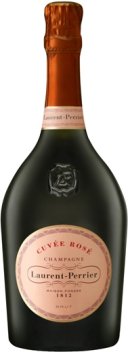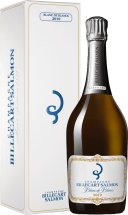Larmandier Bernier Longitude Non-Vintage
Laherte Frères Blanc de Blancs Nature Champagne Non-Vintage
Laherte Frères Blanc de Blancs Nature is made with the best parcels of Chardonnay (located on the south slopes of Epernay and the Côte des Blancs). This wine is very representative of the purity and the minerality of the Chardonnay.
Laurent Perrier Rose
'Rose were for long regarded as the illegitimate offspring of Champagne, recipients of coarse, heavy pressings wines partially masked by high dosage levels. Today they are routinely priced above 'normal' NV (or vintage) blends and are carefully made. Whether they really merit the premium is irrelevant: the market has spoken. But Laurent-Perrier is a special case: this is 100% pinot noir, rather than a blend coloured by pinot noir red wine. The full salmon colour is an immediate indication of its provenance, the bouquet complex and alluring, leading directly into the cherry and strawberry flavours of the long, sustained palate; excellent finish and aftertaste.' - 95 points, James Halliday Top 100
Billecart Salmon Blanc De Blanc Vintage
An exceptional fermentation with a mineral style which wonderfully accompanies Ossetra caviar or fi ne marinated sashimi or grilled fi sh.
Billecart-Salmon Brut Rosé Champagne
Perrier Jouet Blanc de Blancs
Perrier-Jouet is one of France's most historic and distinctive champagne houses. With over 200 years of producing elegant floral champagnes from the chardonnay grape, the Perrier -Jouet family has an obsession with quality. Since the 18th Century, the champagne house has only had 7 Cellar Masters. In the mouth the wine is fresh, tangy and invigorating with a mineral intensity on the finish. This is a vivacious wine of immense energy and vitality.
Ruinart Brut Rosé Champagne N V
Delamotte Brut Non-Vintage
Agrapart & Fils 7 Crus Extra-Brut Non-Vintage
Product Information: The NV Brut 7 Crus is a very pretty. Bright, mineral and intensely vibrant, the 7 Crus is full of energy and refreshment. 7 Crus is a blend of two harvests: in this case, 60% is 2021 from 1er Cru sites; and 40% is 2020 from Grand Cru sites. The reserve wine was raised in neutral, 600-litre oak casks from François Chidaine and Didier Dagueneau. The breakdown is 90% Chardonnay and 10% Pinot Noir. Even at this first level, the wine is aged for three years on lees. It was disgorged with 6 g/L dosage. This is the most immediately seductive cuvée in the Agrapart range, yet it is still extremely fine. It’s long, deep and saline with some gentle grip. Sadly, we do not get nearly enough. The reviews below refer to a previous disgorgement. Disg. March 2024. The Agrapart range begins with a non-vintage wine called 7 Crus. The name refers to the seven Côte des Blancs villages from which the wine derives. These include Avize (from younger vines aged 20 to 40 years), Cramant, Oger, Oiry, Avenay-Val-d’Or, Coligny and Vauciennes. Like all Agrapart wines, the fruit is from 100% estate-owned and farmed vineyards. Maker: In 1894 at the beginning of France’s lively Belle Époque “the beautiful era” or Europe's golden era between 1871 to 1914. Arthur Agrapart started the family domaine that would become Champagne Agrapart & Fils. The estate has weathered many storms, including World War I, an economic depression, and the German Occupation during World War II, which devastated stock by millions of cases throughout the region. In the 1950s, Arthur’s grandson Pierre set out to rebuild the family business by making wines of quality rather than following the commercial trends of the day. Pierre’s sons Pascal and Fabrice took over the reins in 1990, farming their own vineyards along the prestigious Côte de Blancs, as well as blending and bottling their own wines. By the early 2000s, upon realising the brothers did not have the same goals for the future of the estate, Pascal began the long-term process of dividing the estate in two. His vineyards would become the backbone of Domaine Pascal Agrapart, focusing on the unique single vineyard cuvées that he had championed since the early 1990s and the remaining family vineyards would provide the fruit for the assemblage cuvées, 7 Crus & Terroirs, still bottled under the Agrapart & Fils label today. Pascal has been joined by his eldest son Ambroise and their ultimate goal is to produce only wines bearing the Pascal Agrapart label. Philosophy: The winery is based in the grand cru village of Avize, famous for its cuvees of 100% Chardonnay. Pascal and Ambroise farm 10 hectares from some 60 different vineyard plots in the Côte de Blancs, including Oger, Cramant, Oiry and Avize. They farm using only homeopathic vine treatments, composts, manures, and regular plowing. The Agraparts were one of the first families to bring the draft horse back to the vineyards, and named a cuvee in honour of their first four-hooved friend, Vénus. In plowing the old-school way, they expose the clay and limestone soils to immune-boosting properties of the wind and sun. While they once were the object of ridicule, they now lead a return to authentic, ancestral practices. Their quality control extends to manual harvests, a selective triage of the grapes, and the use of native yeasts during fermentation. Malolactic fermentations are employed to round out the intensity of these mineral-driven Champagnes. The wines age on their lees for an extended period of time, and then are racked to both stainless steel and neutral oak barrels—the latter being a rarity in Champagne before Pascal started using them. All wines are bottled unfined and unfiltered. Nose - Apricots, Pears, Fennel Vibrant fruit here, with peaches, apricots, lemons, pears, almonds and spicy anise notes. Palate - Intense Minerality, Pillowy Palate, Citrus Peel medium to full-bodied, ample and pillowy palate. Finish - Chalk, Lingering Citrus, Saline White flowers, chalk and citrus linger.
Ayala Le Blanc de Blanc A/18
Product Description: This elegant and complex Champagne is perfect for pairing with fine, simple cuisine that highlights quality ingredients. Enjoy it as an aperitif, or pair it with seafood dishes like scallop carpaccio, citrussy sea bass tartare, or fresh oysters. The vibrant acidity and minerality also make it a perfect match for creamy cheese or vegetable-based starters. Maker: Champagne Ayala, founded in 1860 by Edmond De Ayala, has a long-standing legacy of producing exceptional Champagne with an unwavering commitment to quality. The House of Ayala is renowned for its craftsmanship and innovation, particularly in its focus on creating Champagne that highlights the pure expression of Chardonnay. The company’s roots in the village of Aÿ have remained firm, with the iconic founder's bold decision in 1865 to release "dry champagne" with a minimal dosage, setting a new standard for Champagne production. Ayala continues to honour its founder’s vision by offering wines with elegance, finesse, and the signature purity of Chardonnay. Under the direction of a new generation, particularly since the acquisition by the Bollinger family in 2005, Champagne Ayala has invested heavily in modernising its facilities while maintaining the highest standards of craftsmanship. Their meticulous approach involves working with an extensive selection of crus to ensure that each bottle reflects the best of Champagne's diverse terroirs. Today, the House continues to flourish under the leadership of Hadrien Mouflard, who has spearheaded the transformation of Ayala’s identity with a renewed focus on purity and precision. Philosophy | AYALA: At Champagne Ayala, the philosophy is built on one key principle: "Honor the essence." This guiding belief sees the House dedicated to revealing the purest expression of Chardonnay, the cornerstone of its winemaking. This commitment drives every decision, from vineyard management to vinification, to the final blending process. The House works with a unique and diverse palette of crus, with 50 of the 70 crus exclusively dedicated to Chardonnay, sourced from the finest terroirs of the Champagne region. Ayala’s philosophy embraces organic principles, with a growing commitment to sustainable practices, including the conversion of its own vineyards to organic viticulture, and the pursuit of environmental certifications such as HEV and VDC. The production process at Ayala is a masterclass in precision. Each cru undergoes micro-vinification, allowing the individual characteristics of each vineyard to shine before being carefully blended into the final cuvée. The extended aging of their wines on lees, paired with the low dosage, ensures that Ayala’s champagnes embody an exceptional balance of freshness, complexity, and elegance. This purity and focus on terroir have earned Champagne Ayala a reputation for producing wines that are as distinctive as they are exquisite, with a clarity and freshness that stands out in every bottle. Through these practices, Ayala continues to honour the craftsmanship and legacy of its founder, Edmond De Ayala, while paving the way for a bright future. Tasting Notes: Nose Elegant, Fragrant, Citrusy Aromatic delight, opening with notes of pear, grapefruit, and delicate jasmine, creating a fresh and vibrant bouquet. Subtle hints of acacia honey and a touch of citrus zest enhance the fragrance, providing an inviting and layered profile that draws you in. Palate Fresh, Lively, Structured Vibrant character with lively flavours of blood orange and pastry. The texture is sleek and elegant, with a beautiful minerality. Bright acidity provides structure and balance, giving it an exciting and refreshing finish. Finish Long, Crisp, Mineral Long and crisp, leaving a lasting impression of bright citrus and chalky minerality. The purity of the Chardonnay shines through, with a delicate balance between freshness and complexity that continues to evolve with each sip.











